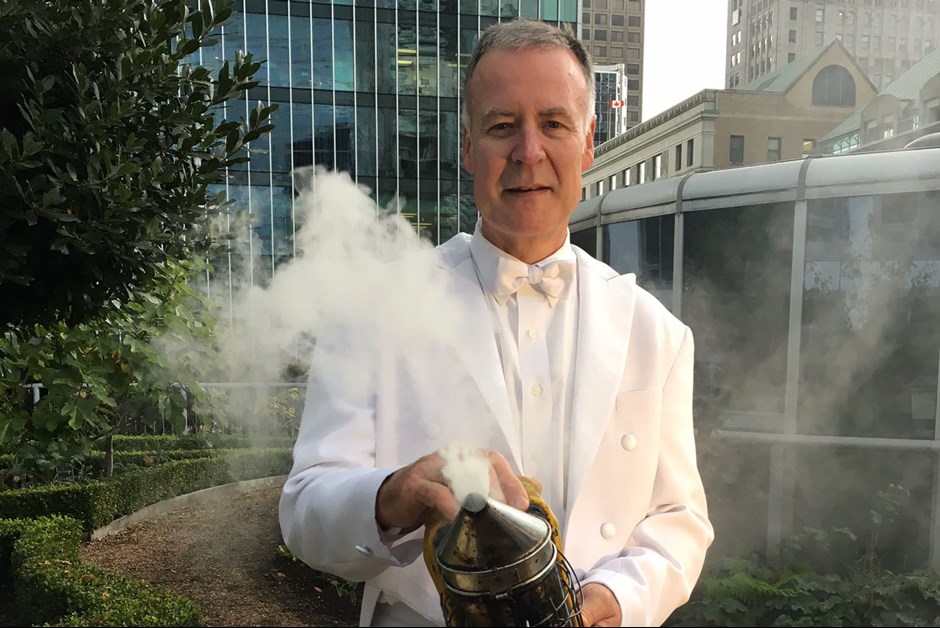THE LAST OF THE SUMMER BEES ~ THE BUZZ ON FAIRMONT BEES WITH BEE BUTLER MICHAEL KING
Learn more about Fairmont Waterfront or make a booking.
Here we are just days away from the end of the summer of 2016 and for beekeepers across the province the preparations for overwintering their hives are well under way. Our 4 hives and our observation hive have provided many a great memory for hundreds of our guests and visitors who have participated in our daily bee tours every day since early May. Our Bee Team and I hope that the education and the awareness we have brought to each and every guest will rub off in the form of personal actions taken by each of them to support their local bee populations wherever they live in the world. Small actions taken by people worldwide are needed to help bees do more than merely survive. Planting flowers, putting up a mason bee nesting box, leaving a small wild space in a garden where indigenous plant life can flourish and help make gardens and patios ‘bee friendly places.’
At months end our Fairmont Waterfront bees were removed under cover of darkness and taken to their overwintering site at the Cloverdale-Langley location of the Honeybee Centre. The hotel does not have the essential elements and equipments to properly care for our hives on the roof and because it is an exposed location in winter months our bees deserve the care and attention they get at the Honeybee Centre.
Elsewhere, hives are being managed down by reducing the size of hives from 2, 3 or 4 soupers down to one. Hive populations which are now starting to decline naturally are housed in space that allows them to keep warm in numbers as they huddle together in the cooler evenings of late summer and early fall.
The honey has been harvested frame by frame and the beekeeper ensures that they keep enough frames of honey aside to keep the bees sustained with the most natural source of food for them which is their own honey and nectar. For the winter supply this equates to about 2 frames of pollen and 5 frames of honey.
The hive will receive treatments for two issues, one being the Varroa mite and the other being a tiny fungus called Nosema which forms spores in the hive and usually begins from damp conditions in the hive.
The life of the colony continues as fall begins. The older bees in the hive who are the foraging or field bees will continue to journey out of the hive in search of the last sources of nectar and pollen to bring back to the colony and the younger bees will remain inside the hive and tend to the work that is required of them, namely feeding the brood, tending to the Queen, guarding the hive from unwelcome visitors like the wasp and building comb as needed.
At this time the feeding of sugar syrup will also begin with perhaps up to 6 gallons of the liquid required depending on the bees needs.
The bee colony at this time of the year is in transition and the Queen will begin laying fewer eggs in the hive as she senses a change in weather and a drop in the food supplies being brought into the hive by the workers. It is at this time of the year that the male bees will be forced out of the hive by the workers who know only too well that a bee whose work ethic is almost nonexistent and who has to be fed by the females to survive, is a drain on the colony resources and simply must be removed from the hive. The males who have no stinger to protect themselves and who are not able to feed themselves will perish within a day or two either from predation or starvation. No bee is allowed to remain in the hive overwinter unless they are able to contribute to the health of the colony and so the males pay for the price for their gender at this stage in the year!
The life span of a worker bee in spring and summer is around 28-35 days due to the great exertions they put their bodies under while working diligently in the hive and then by flying thousands of miles as they search for nectar and pollen, however, in winter the worker bees will expend very little energy other than keeping warm in the hive and eating to sustain themselves, they will live up to 4 months and perhaps longer ready to emerge in early spring as foraging bees ready to begin the re-population of the hive and bring in those early and vital supplies of new pollen and nectar from early season flowers.
What happens to the hive and in the hive at this time of the year may well determine how well that colony performs next year so getting your hives ready for winter and treating them properly and well is a bee keepers main concern. It is then left up to the beekeeper to wait out the long months of winter making occasional visits to the wrapped and protected hives for a quick inspection and hoping that come early February the colony is successful in coming through the winter ready to bring another year of pollination and germination to our gardens, parks, orchards, allotments, pastures and fields of vegetables and fruits and food to our tables.
Give your local bees a big thank you for another year of life, for as was once said by Albert Einstein, “If the bee disappeared off the surface of the globe, then man would have only 4 years of life left, no more bees, no more pollination, no more plants, no more animals, no more man.”
Learn more about our bees at: Fairmont Waterfront Green Hotel Initiatives
For more #BeeButler posts visit: Fairmont Buzz on Bees
#FairmontBuzz #BuzzOnBees #BeeButler #BeeSustainable
